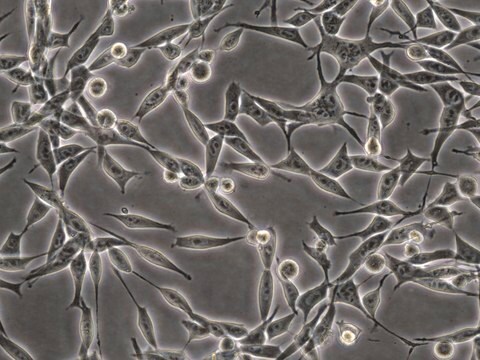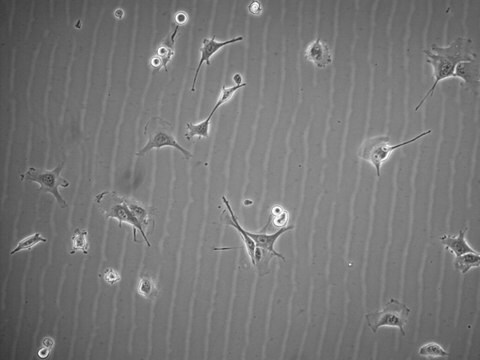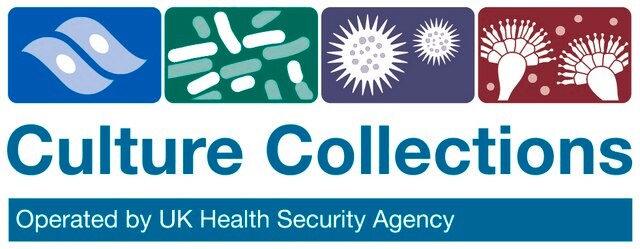SCC420
B16-OVA MO4 Mouse Melanoma Cell Line
Mouse
Sinónimos:
B16-OVA MO4 Cell Line, Melanoma Cell Line, Mouse Melanoma Cells
Iniciar sesiónpara Ver la Fijación de precios por contrato y de la organización
About This Item
UNSPSC Code:
41106514
NACRES:
NA.71
Productos recomendados
product name
B16-OVA MO4 Mouse Melanoma Cell Line,
biological source
mouse
packaging
vial of >1X10⁶ cells
manufacturer/tradename
Millipore
growth mode
N/A
technique(s)
cell culture | mammalian: suitable
shipped in
dry ice
storage temp.
−196°C
General description
The immune system can recognize and destroy tumors. Cytotoxic T lymphocytes (CTLs) kill neoplastic (or virally infected) cells after recognizing antigenic peptides bound to major histocompatibility complex (MHC) class I molecules on their surface. These peptides are derived from antigens that are degraded in the cytosol of the affected cell. Immunizations with killedpathogens or their proteins do not generally elicit CTLs, because exogenous proteins cannot enter the cytosol (to bepresented). However, antigens that are internalized into phagocytic cells can enter the cytosol and be processed for classI presentation. Immunization with a purified antigen attached to an avidly phagocytized particle primes CTLs, which in turnprotect animals from subsequent challenge with tumors transfected with the antigen gene.
Application
- Each vial contains >1X106 viable cells.
- Cells are tested negative for infectious diseases by a Mouse Essential CLEAR panel by Charles River Animal Diagnostic Services.
Cells are verified to be of mouse origin and negative for inter-species contamination from rat, Chinese hamster, Golden Syrian hamster, human and non-human primate (NHP) as assessed by a Contamination CLEAR panel by Charles River Animal Diagnostic Services.
- Cells are negative for mycoplasma contamination.
Background
The immune system can recognize and destroy tumors. Cytotoxic T lymphocytes (CTLs) kill neoplastic or virally infected cells after recognizing antigenic peptides bound to major histocompatibility complex class I molecules on their surface. These peptides are derived from antigens that are degraded in the cytosol of the affected cell. Immunizations with killed pathogens or their proteins do not generally elicit CTLs, because exogenous proteins cannot enter the cytosol (to be presented). However, antigens that are internalized into phagocytic cells can enter the cytosol and be processed for class I presentation. Immunization with a purified antigen attached to an avidly phagocytized particle primes CTLs, which in turn protect animals from subsequent challenge with tumors transfected with the antigen gene.1
Source
Tumor rejection antigens – TRAs – differ from any other protein synthesized by the cell in that the host is intolerant to them. Thus virtually any foreign protein synthesized by a tumor, including those expressed from foreign antigen genes transfected into tumor cells, should function and behave like TRAs. This hypothesis was tested in a murine tumor model developed by transfecting the chicken ovalbumin gene into the C57BL/6 (H-2b haplotype)-derived murine melanoma cell line B16, followed by selection and isolation of the ovalbumin (OVA)-transfected B16 clone B16-OVA MO4.1
In in vitro challenge, B16-OVA MO4 cells stimulated the OVA+ Kb-specific T-cell hybridoma RF33.70 to produce interleukin-2 whereas untransfected B16 cells did not. Injected intradermally into syngeneic C57Bl/6 mice, both B16 and B16-OVA MO4 grew progressively, metastasized, and killed the animals showing that expression of the ovalbumin antigen alone does not render this tumor sufficiently immunogenic to be rejected. Subcutaneous immunization of C57Bl/6 mice with ovalbumin conjugated to iron beads (OVA-Fe), however, protected B16-OVA MO4 (but not B16) challenged animals both from local tumor growth and death. This approach could be exploited to develop tumor and viral vaccines.1
References
1. Falo LD Jr, Kovacsovics-Bankowski M, Thompson K, Rock KL. Nat. Med. 1995; 1(7):649-653.
2. Fidler IJ. Cancer Res. 1975; 35(1):218-224.
Note: Mouse xenotropic retrovirus Bxv-1 proviral DNA is detected in B16-OVA MO4 cells, BXV-1 is a Biosafety Level 2 (BSL-2) pathogen.
The immune system can recognize and destroy tumors. Cytotoxic T lymphocytes (CTLs) kill neoplastic or virally infected cells after recognizing antigenic peptides bound to major histocompatibility complex class I molecules on their surface. These peptides are derived from antigens that are degraded in the cytosol of the affected cell. Immunizations with killed pathogens or their proteins do not generally elicit CTLs, because exogenous proteins cannot enter the cytosol (to be presented). However, antigens that are internalized into phagocytic cells can enter the cytosol and be processed for class I presentation. Immunization with a purified antigen attached to an avidly phagocytized particle primes CTLs, which in turn protect animals from subsequent challenge with tumors transfected with the antigen gene.1
Source
Tumor rejection antigens – TRAs – differ from any other protein synthesized by the cell in that the host is intolerant to them. Thus virtually any foreign protein synthesized by a tumor, including those expressed from foreign antigen genes transfected into tumor cells, should function and behave like TRAs. This hypothesis was tested in a murine tumor model developed by transfecting the chicken ovalbumin gene into the C57BL/6 (H-2b haplotype)-derived murine melanoma cell line B16, followed by selection and isolation of the ovalbumin (OVA)-transfected B16 clone B16-OVA MO4.1
In in vitro challenge, B16-OVA MO4 cells stimulated the OVA+ Kb-specific T-cell hybridoma RF33.70 to produce interleukin-2 whereas untransfected B16 cells did not. Injected intradermally into syngeneic C57Bl/6 mice, both B16 and B16-OVA MO4 grew progressively, metastasized, and killed the animals showing that expression of the ovalbumin antigen alone does not render this tumor sufficiently immunogenic to be rejected. Subcutaneous immunization of C57Bl/6 mice with ovalbumin conjugated to iron beads (OVA-Fe), however, protected B16-OVA MO4 (but not B16) challenged animals both from local tumor growth and death. This approach could be exploited to develop tumor and viral vaccines.1
References
1. Falo LD Jr, Kovacsovics-Bankowski M, Thompson K, Rock KL. Nat. Med. 1995; 1(7):649-653.
2. Fidler IJ. Cancer Res. 1975; 35(1):218-224.
Note: Mouse xenotropic retrovirus Bxv-1 proviral DNA is detected in B16-OVA MO4 cells, BXV-1 is a Biosafety Level 2 (BSL-2) pathogen.
Features and Benefits
B16-OVA MO4 cell line is a model for cancer immunotherapy, expressing ovalbumin (OVA) in order to facilitate strong immune responses to tumor antigens.
Storage and Stability
Cells should be stored in liquid nitrogen until use. The cells can be cultured for at least 10 passages after initial thawing without significantly affecting the cell marker expression and functionality.
Other Notes
This product is intended for sale and sold solely to academic institutions for internal academic research use per the terms of the “Academic Use Agreement” as detailed in the product documentation.
Disclaimer
Unless otherwise stated in our catalog or other company documentation accompanying the product(s), our products are intended for research use only and are not to be used for any other purpose, which includes but is not limited to, unauthorized commercial uses, in vitro diagnostic uses, ex vivo or in vivo therapeutic uses or any type of consumption or application to humans or animals.
Storage Class
10 - Combustible liquids
wgk_germany
WGK 2
flash_point_f
Not applicable
flash_point_c
Not applicable
Certificados de análisis (COA)
Busque Certificados de análisis (COA) introduciendo el número de lote del producto. Los números de lote se encuentran en la etiqueta del producto después de las palabras «Lot» o «Batch»
¿Ya tiene este producto?
Encuentre la documentación para los productos que ha comprado recientemente en la Biblioteca de documentos.
Nuestro equipo de científicos tiene experiencia en todas las áreas de investigación: Ciencias de la vida, Ciencia de los materiales, Síntesis química, Cromatografía, Analítica y muchas otras.
Póngase en contacto con el Servicio técnico







